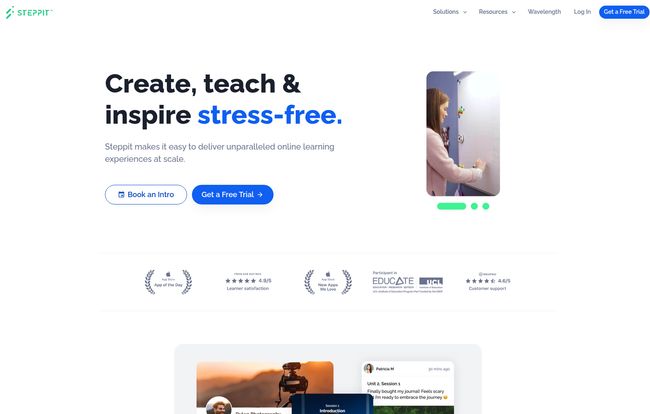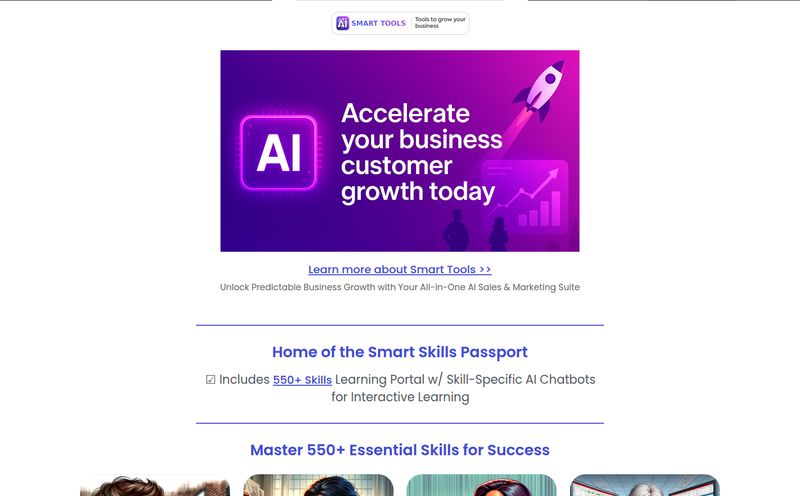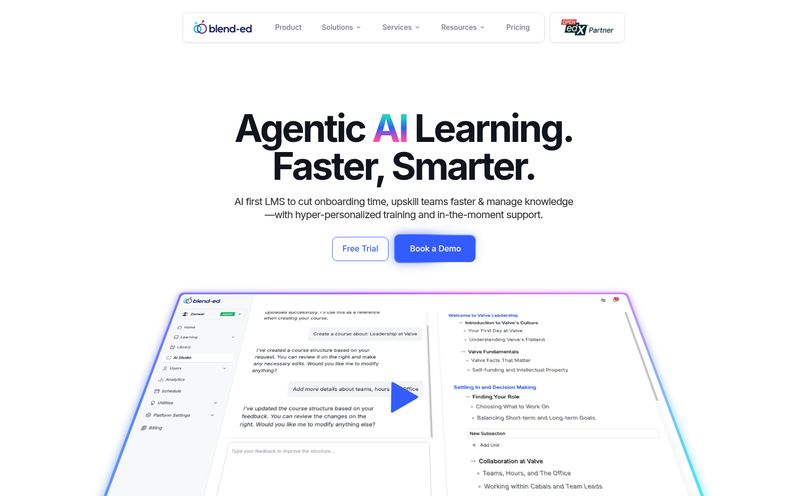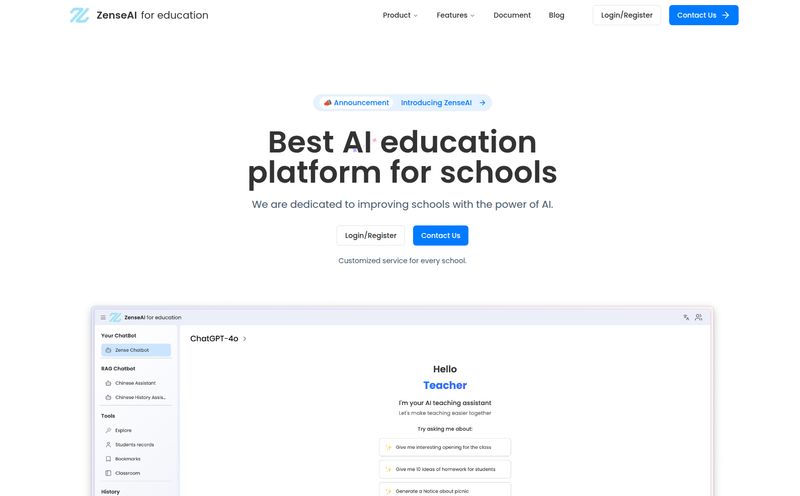Everyone and their dog wants to create an online course. And why not? The creator economy is booming, and you've got valuable knowledge sitting in that brain of yours. But then reality hits. The planning. The scripting. The filming, the editing, the tech setup... it’s a whole thing. I’ve seen more brilliant experts give up on their course idea than I can count, all because the process felt like trying to build a spaceship with a glue stick.
It's a genuine pain point in our industry. We spend so much time talking about traffic and conversions that we forget the massive hurdle of just creating the thing in the first place.
So when a tool like Steppit comes along, promising an "AI-assisted" and "stress-free" way to create and sell courses, my seasoned SEO-blogger senses start tingling. Is it just another platform with a slick landing page, or could it actually be the answer so many creators have been looking for? I decided to take a look under the hood.
So What is Steppit, Really?
At its core, Steppit is an online course platform. You can build courses, enroll students, and get paid. Simple enough. But its secret sauce is a two-part recipe: a clever AI assistant and a very modern, "short-form-first" approach to content.
Think of it less like a traditional, clunky Learning Management System (LMS) from the 2010s and more like a smart, intuitive partner. It’s built for people who have expertise to share but don't necessarily want to become full-time video editors or web developers. It feels like its aimed squarely at tutors, coaches, niche experts, and corporate trainers who just want to get their knowledge out there without all the fuss.

Visit Steppit
The Steppit Features I Genuinely Like
I’ve tested more platforms than I care to admit, and many of them are just clones of each other. Steppit has a few things that made me sit up and pay attention.
Your New AI Teaching Assistant
Okay, I’m a skeptic when it comes to AI in creative work. Often, it just spits out generic nonsense. But Steppit’s AI assistant (available on the paid plans) is surprisingly practical. It’s designed to bust through creator's block. You can feed it a topic, and it will help you generate a course outline, lesson ideas, and even draft some starting content. It's not going to write the whole course for you—and it shouldn't—but it's fantastic for getting the ball rolling. It turns that terrifying blank page into a manageable series of prompts. For me, that’s its biggest win.
A "Short-Form-First" Mentality
This is the part that feels truly innovative. Instead of pushing you to create massive, hour-long video lectures, Steppit encourages a “short-form-first” structure. Think of building your course with small, digestible blocks of content. A short video here, a quick text guide there, a simple interactive poll. It’s how people consume content on TikTok and Instagram Reels, and applying that to education just makes sense. It’s less intimidating for the creator to produce and way easier for the student to absorb. It’s a design choice that respects modern attention spans, and I'm here for it.
Building a Real Community
So many course platforms are static. Students buy a course, watch videos alone, and that's it. Steppit injects a much-needed social element. You can run cohort-based classes where everyone starts together, or create private class feeds and group chats. This transforms a passive viewing experience into an active learning community. Students can ask questions, share their progress, and interact with each other. This is huge for keeping learners engaged and reducing refund rates, something any seasoned course creator worries about.
Let's Talk Money: The Steppit Pricing Plans
Alright, this is the make-or-break section for most people. How much is this thing going to cost? Steppit's pricing is tiered, and honestly, it’s pretty competitive. They have a legit free plan, which is always a good sign.
Here's a quick rundown of their monthly plans:
| Plan | Price/Month | Who It's For | Key Details |
|---|---|---|---|
| Free | $0 | The Curious & Testers | Create 2 small courses, max 5 learners per course. No AI. Great for a trial run. |
| Starter | $25 | Your First Paid Course | Unlocks the AI assistant. Up to 20 private learners + unlimited public ones. |
| Growth | $67 | Growing Creators | Higher limits on courses and learners, plus the option to embed courses on your own site. |
| Scale | $117 | Established Businesses | Highest caps, dedicated support, and all the bells and whistles for scaling up. |
My take? The Free plan is perfect for getting a feel for the platform without any commitment. The Starter plan at $25/month is a fantastic entry point for anyone serious about launching their first paid course. It gives you the AI tools without a huge financial leap.
The Not-So-Great Stuff (Full Transparency)
No tool is perfect, and it would be dishonest to pretend otherwise. There are a couple of things you should be aware of before jumping in.
The Inevitable Revenue Share
Like many platforms that handle payments for you, Steppit takes a percentage of your course sales made via their system. This is a pretty standard industry practice—it's the tradeoff for not having to mess with Stripe or PayPal integrations yourself. However, its something you need to factor into your pricing strategy. For some creators who want to keep 100% of their revenue (minus standard payment processing fees), this could be a dealbreaker.
Those Confusing Enrollment Limits
This was the one part that made me scratch my head. The Pro plans (Starter, Growth, Scale) have limits on enrollments from "invites or external integrations" (like 20 on the Starter plan). At first glance, this seems incredibly low. However, after digging in, it seems enrollments from a public course link or the Steppit channel page are unlimited. This distinction is super important and not immediately obvious. It's designed to manage high-volume enrollments via integrations like Zapier, but it could definitely be explained better on their pricing page.
My Final Verdict: Should You Give Steppit a Shot?
After spending some time with it, I’m genuinely optimistic about Steppit. It's not trying to be a massive, all-in-one marketing machine like Kajabi. It's not a crowded, cut-throat marketplace like Udemy. It has carved out a very specific, and very smart, niche for itself.
You should definitely check out Steppit if:
- You're an expert, coach, or tutor who is intimidated by the tech of creating a course.
- You believe in active, community-based learning over passive video consumption.
- Your content naturally breaks down into smaller, bite-sized lessons.
- You just want to get your course done without a million distractions.
You might want to look elsewhere if:
- You're a power-user who needs complex sales funnels and dozens of native integrations.
- You are allergic to any kind of revenue-sharing model.
Ultimately, Steppit feels like a breath of fresh air. It’s a modern tool built for the way we teach and learn today. If you've got an idea for a course that's been collecting dust, this might be the kick in the pants you need to bring it to life.
Frequently Asked Questions about Steppit
What is the revenue share that Steppit takes?
Steppit takes a platform fee on sales made through its checkout system. The exact percentage can vary, so it's best to check their current terms. This is in addition to standard credit card processing fees.
Can I use my own branding on my Steppit courses?
Yes! Steppit allows you to create a branded channel page and course landing pages, so your students get an experience that feels like it's coming directly from you, not a generic platform.
Is the AI course assistant actually useful?
In my opinion, yes. It's not a magic wand, but it's excellent for overcoming the initial hurdle of outlining a course and generating ideas. It provides a solid foundation to build upon, which can save hours of brainstorming time.
Can I offer free courses or content on Steppit?
Absolutely. The platform supports creating free courses and sessions, which is a fantastic strategy for building an audience, generating leads, or providing a free resource for your community.
What kind of integrations does Steppit support?
The pricing page mentions integrations with your favorite apps via Zapier. This allows you to connect Steppit to thousands of other tools for things like email marketing, CRM, and more, though heavy use might be impacted by those enrollment limits we discussed.
What's the difference between a cohort-based class and an instant-access course?
Instant access (or evergreen) means students can enroll anytime and go through the material at their own pace. A cohort-based class has a set start and end date, where a group of students progresses through the material together, often with live elements and a stronger community feel.
Reference and Sources
- Steppit Official Website
- Steppit Official Pricing Page
- The Creator Economy Needs a Middle Class - Harvard Business Review



